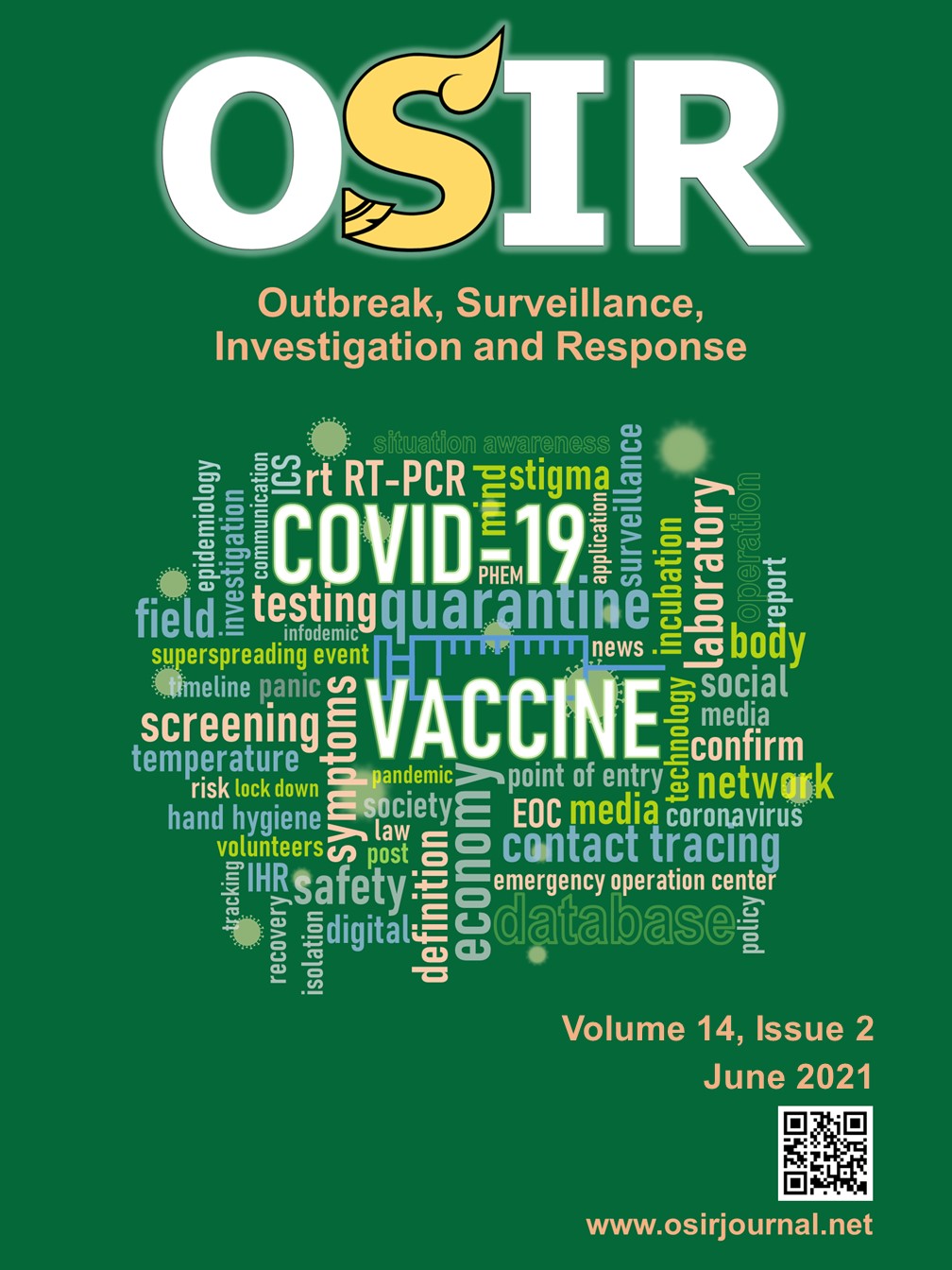School Management in Response to Coronavirus Disease 2019
DOI:
https://doi.org/10.59096/osir.v14i2.262691Keywords:
Coronavirus, COVID-19, school, modelAbstract
The coronavirus disease 2019 (COVID-19) outbreak emerged in Thailand in January 2020 with the situation worsening during March-April 2020. The government decided to lockdown most public places, including schools and daycare nurseries even though the proportion of cases in under 15-year-old was small (about 2.8%). Evidence at the global level did not reach consensus on how to manage school openings properly. The Department of Health of the Ministry of Public Health has delivered school guidelines for the prevention and control of COVID-19. The modelling team of the Department of Disease Control demonstrated that the risk of an infective presenting with a long incubation period (more than seven days) was approximately 12%. This figure reduced to only 1% if a fourteen-day cutoff was applied. The infectivity risk did not depend on the incubation period alone, but greatly relied on the ability of a school to detect a case. With a timely and comprehensive detection rate (close to 100%), a seven-day closure policy yielded almost the same infectivity risk as a fourteen-day closure policy. Policy makers should bring the issues of health, education, and the social impact of children to the table and identify the most appropriate measures to control COVID-19 while ensuring the best quality of life of a child.
References
World Health Organization Thailand. Coronavirus disease 2019 (COVID-19). Nonthaburi: WHO Country Office for Thailand; 2021.
Marome W, Shaw R. COVID-19 response in Thailand and its implications on future preparedness. Int J Environ Res Public Health. 2021;18(3):1-11. doi:10.3390/ijerph18031089.
Department of Disease Control. Daily COVID-19 situation of Thailand [dataset on the internet]. Bangkok: Digital Government Development Agency; 2020 [updated 2021 Jun 21, cited 2021 Jun 21]. <https://data.go.th/en/dataset/covid-19-daily>
Bhuiyan MU, Stiboy E, Hassan MZ, Chan M, Islam MS, Haider N, et al. Epidemiology of COVID-19 infection in young children under five years: A systematic review and meta-analysis. Vaccine. 2021;39(4):667-677. doi:10.1016/j.vaccine.2020.11.078.
Romero Starke K, Petereit-Haack G, Schubert M, et al. The age-related risk of severe outcomes due to covid-19 infection: A rapid review, meta-analysis, and meta-regression. Int J Environ Res Public Health. 2020;17(16):5974. doi:10.3390/ijerph17165974.
Esposito S, Principi N. Mask-wearing in pediatric age. Eur J Pediatr. 2020;179(8):1341-2. doi:10.1007/s00431-020-03725-1.
Stein-Zamir C, Abramson N, Shoob H, Libal E, Bitan M, Cardash T, et al. A large COVID-19 outbreak in a high school 10 days after schools’ reopening, Israel, May 2020. Euro Surveill. 2020;25(29):2001352. doi:10.2807/1560-7917.ES.2020.25.29.2001352
Torres JP, Piñera C, De La Maza V, et al. Severe acute respiratory syndrome coronavirus 2 antibody prevalence in blood in a large school community subject to a coronavirus disease 2019 outbreak: a cross-sectional study. Clin Infect Dis. 2020 Jul 10:ciaa955 . doi:10.1093/cid/ciaa955.
Xu W, Li X, Dozier M, et al. What is the evidence for transmission of COVID-19 by children in schools? A living systematic review. J Glob Health. 2020;10(2):021104. doi:10.7189/jogh.10.021104.
Otte im Kampe E, Lehfeld A-S, Buda S, Buchholz U, Haas W. Surveillance of COVID-19 school outbreaks, Germany, March to August 2020. Euro Surveill. 2020;25(38):2001645. doi:10.2807/1560-7917.ES.2020.25.38.2001645.
Viner RM, Russell SJ, Croker H, et al. School closure and management practices during coronavirus outbreaks including COVID-19: a rapid systematic review. Lancet Child Adolesc Health. 2020;4(5):397-404. doi:10.1016/S2352-4642(20)30095-X.
Fry-Bowers EK. Children are at Risk from COVID-19. J Pediatr Nurs. 2020;53:A10-A12.
Singh S, Roy D, Sinha K, Parveen S, Sharma G, Joshi G. Impact of COVID-19 and lockdown on mental health of children and adolescents: A narrative review with recommendations. Psychiatry Res. 2020;293:113429. doi:10.1016/j.psychres.2020.113429.
United Nations Children’s Fund Thailand. School reopening: How teachers and students are adjusting to the new normal in Thailand [Internet]. Bangkok: United Nations Children’s Fund Thailand; 2020 Sep 8 [cited 2020 Oct 1]. <https://www.unicef.org/thailand/stories/school-reopening-how-teachers-and-students-are-adjusting-new-normal-thailand>
Department of Health. The Guidelines for Reopening Education Institutions during COVID 19 Pandemic. Nonthaburi: Department of Health, Ministry of Public Health, Thailand; 2020.
Riou J, Althaus CL. Pattern of early human-to-human transmission of Wuhan 2019 novel coronavirus (2019-nCoV), December 2019 to January 2020. Euro Surveill. 2020;25(4):2000058. doi:10.2807/1560-7917.ES.2020.25.4.2000058.
Nishiura H, Linton NM, Akhmetzhanov AR. Serial interval of novel coronavirus (COVID-19) infections. Int J Infect Dis. 2020;93:284-6. doi:10.1016/j.ijid.2020.02.060.
Linton NM, Kobayashi T, Yang Y, Hayashi K, Akhmetzhanov AR, Jung SM, et al. Incubation period and other epidemiological characteristics of 2019 novel coronavirus infections with right truncation: a statistical analysis of publicly available case data. J Clin Med. 2020;9(2):538. doi:10.3390/jcm9020538.
Larsen L, Helland MS, Holt T. The Impact of School Closure and Social Isolation on Children in Vulnerable Families during COVID-19: A Focus on Children’s Reactions. Eur Child Adolesc Psychiatry. 2021 Mar 26:[11 p).doi:10.31234/OSF.IO/DEJU9.
Garbe A, Ogurlu U, Logan N, Cook P. Parents’ Experiences with Remote Education during COVID-19 School Closures. AM J QUALITATIVE RES. 2020;4(3):45-65. doi:10.29333/ajqr/8471.
Downloads
Published
How to Cite
Issue
Section
License
Copyright (c) 2023 Outbreak, Surveillance, Investigation & Response (OSIR) Journal

This work is licensed under a Creative Commons Attribution-NonCommercial-NoDerivatives 4.0 International License.









